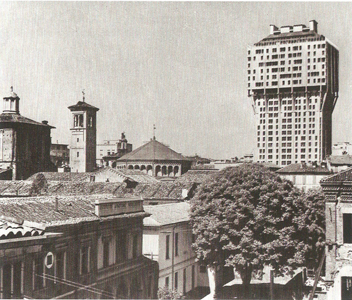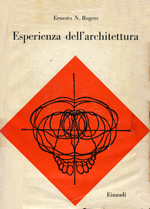You are in: Home page > Magazine Archive > Ernesto Natahan Rogers and the Heart of the City

Federica Visconti
Ernesto Natahan Rogers and the Heart of the City
In 1951, during the VIII CIAM Conference in Hoddesden, England, Ernesto Nathan Rogers gave a talk with the title Il Cuore: problema umano della città (The Heart: human issue of the city). The talk was published, four years later and with some changes, in the book E.N. Rogers, J.L. Sert, J. Tyrwhitt, Il cuore della città: per una vita più umana della comunità, Hoepli publisher, and, in 1958 by Einaudi, in the Rogers’s book Esperienza dell’architettura.
Sixty years later, the talk seems still topical - even if with some instructions - and so useful to steer the reasoning round to the subject of the project into the historical city.
A first point is about the choice of the word heart. Rogers wrote that this word is capable to describe not only geometrical and functional characters - as the word ‘centre’ - but the idea of a central place where, more than in others, the values of a human community are resumed: rather, this is the most important mark. In fact the geometrical position is not important and a city could have more than one centre; in the same way the function is not decisive because the heart of the city - as Rogers wrote - is a place for the most different human relationships and, in this best meaning, the most natural expression of the contemplation (cf Rogers, 1997, 260).
Starting from this kind of premise about the definition of the expression heart of the city, Rogers, as militant architect, identified two opposite, but equally dangerous, attitudes: the levelling cosmopolitism and the demagogic folklorism (cf Rogers, 1997, 258). Blindly destroying and passively preserving are the results of the same mental aridity: they are moral faults (cf Rogers, 1997, 258) - Rogers wrote - and, after more than sixty years, this sentence seems a double and painful premonition. On one side, it’s today possible to look at what in some emerging countries, from the point of view of the economy - China but also India or some South American countries - happens: here the contemporary megalopolis is devouring the land, indifferent towards form and function of the territory and towards the local values of identity. On the other side, in the old Europe for example, the historical centres are often embalmed, with a frequent paradox: buildings similar to enlarged design images (as defined by Vittorio Gregotti) appear into the heart of the city and it isn’t possible to define them monuments because these architectures don’t represent the values of a community but only the architect that designed them and economical values of some groups.
But Rogers was not only a militant architect but an acting too. So, after the criticism, Rogers showed a possible way, a method founded on the dialectic between the opposite terms of what is objective and what is subjective (cf Rogers, 1997, 259). On this subject, to tell the truth, Rogers took more time in explaining the need of the method - his favourite master of the Modern Movement was Walter Gropius - than its contents that, in any case, sub specie topicality, could be explained as the relationship between analysis and project.
The heart of our cities is a place rich of values and these values are, above all, formal values and moreover they have to represent the values of the community that there recognize itself. The objectivity should be in the capability in recognizing these values (analysis) in a critical and selective way; the subjectivity is in the choosing of possible solutions - that are not infinite because solutions have to be coherent with the individuation of the values - able to represent a transformation (project) in continuity with the tradition of our places and of our work as architects.
Following this reasoning, it’s difficult not to think of Torre Velasca (BBPR, 1958) that, with its profile 100 meters high, sets itself up on Milan: modern, perhaps brave for its technical and construction solutions, nevertheless intrinsically bound up with the characteristics of the Lombard architecture and with the form of ‘its’ city.
Bibliography
Rogers, E.N. (1955). Il Cuore: problema umano della città. In Rogers, E.N. Sert J.L., Tyrwhitt, J., Il cuore della città: per una città più umana delle comunità. Milano: Hoepli.
Rogers, E.N. (1958). Esperienza dell’architettura. Torino: Einaudi.
Rogers, E.N. (1997). Esperienza dell’architettura. Milano: Skira, 257-260.
Federica Visconti (1971), PhD in Urban Design, is now Associate Professor in Architectural and Urban Composition at the Faculty of Architecture of the University of Naples “Federico II”.















